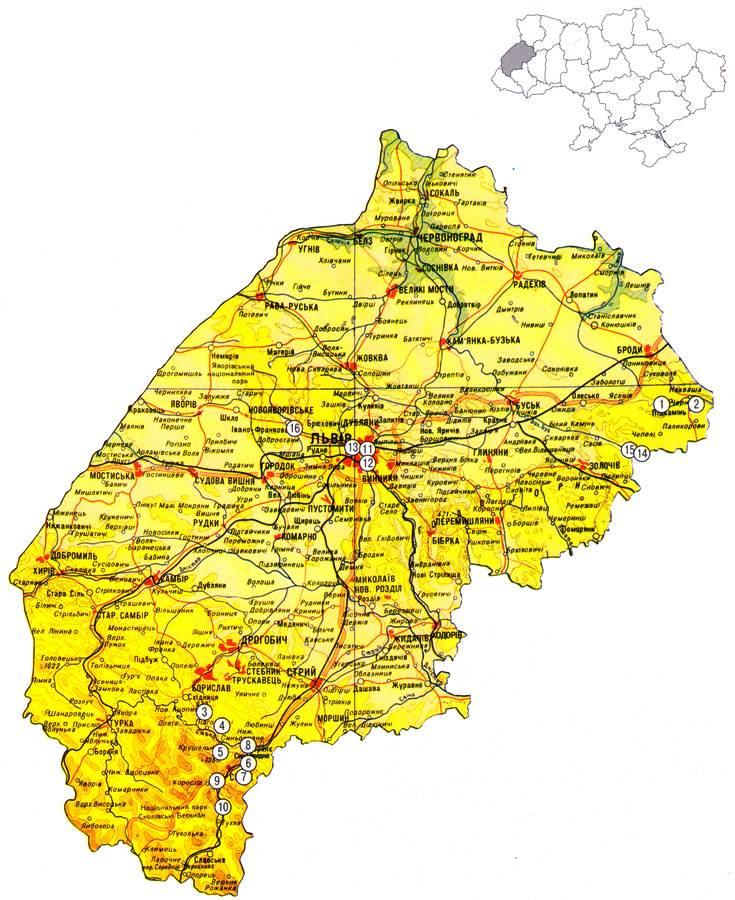GEOLOGICAL LANDMARKS OF UKRAINE. LVIV REGION.
Lviv Region is situated at the . boundary between two major geostructures — margin of Eastern-European Platform and Carpathian Mega-Thrust.
The Platform basement comprises metamorphic schists and granitoids of Archean and Proterozoic age which are overlain by thick Vendian, Paleozoic and Mesozoic sedimentary cover where several structure levels are distinguished — Dnistrovska peri-cratonic monocline, Lvivskiy Paleozoic Depression, Stryiskiy Jurassic trough, and Lvivska Cretaceous mold. The Cenosoic structure level comprises thin Miocene marine and Pleistocene continental fluvial (glacial), subaerial (loess-like loams and soils), and sub-aqual (alluvial) sediments.
Carpathian Mega-Thrust is the uniform fold thrust mega-structure of which within Lviv Region are traced only north-eastern elements of the External Carpathians (Skyboviy Nappe and Krosnenska Zone), and Fore-Carpathian Trough. In the Skyboviy Nappe there are distinguished thrust-folded structures of secondary order — nappes (large “flakes”). From south-west the Krosnenska Zone adjoins Skyboviy Nappe. Tectonic relationships between these elements remain the subject of discussions. All the structures of External Carpathians are composed of Cretaceous — Early Miocene flysch rocks.
Fore-Carpathian Trough is subdivided into Internal Thrust-Folded (allochthonous) and External (autochthonous) sections. In the first one there are traced two secondary-order structures — Boryslavsko-Pokutskiy and Sambirskiy Thrusts. From these the first one mainly includes deep-seated folds that form several levels complicated by nappes. They comprise flysch sediments of the Carpathian age which are overlain by thick Early Miocene often highly salted molassa that also includes olistostrome rocks. Sambirskiy Thrust is made of a range of nappes composed of Miocene molassa only which over considerable distance is over-thrusted onto the sediments of the trough’s external part. The External (Bilche-Volytska) Zone of the Trough is actually margin of the Eastern-European Platform buried down along the system of north-west strike faults and also includes the upper level of epiorogenic zones (Rava-Ruska and Kokhanivska) filled with the thick Upper Miocene molassa laying on the different older platform structure elements.
The relief of Region is fairly variable. In south-west (Internal Carpathians) it is low-medium-height mountain, in Fore-Carpathians and Volynska Height — hill-height, in Podilska Height — humpy, in Male Polissya and Verkhnyosanska Plain — plain one. The External strip of Carpathians comprises Beskydy parallel ridges and valleys which common height varies from 750 m (Verkhnyodnistrovski Beskydy) to 1350 m (Skolivski Beskydy). In Fore-Carpathians which are separated from Ukrainian Carpathians (inside the Region) by Dnister River valley significant areas are covered by the river terrace surfaces. Podilska Height with flat-topped watersheds and steep slopes is essentially dismembered by the river and gully valleys. Male Polissya is flatplain in the central part and slightly-wavy at the margins surrounded by prominent ledges in relief.
Sourсe: Geological Landmarks of Ukraine: In 3 volumes/V.P. Bezvynniy, S.V. Biletski, O.B. Bobrovetal.; V.L. Kalinin, D.S. Gurskiy, I.V. Antakova, Eds. — K.: DIA, 2006. — Volume I.

Comment